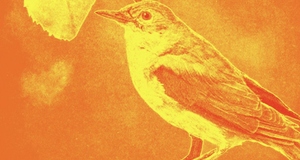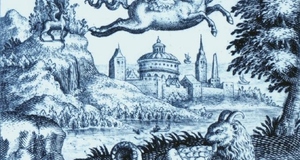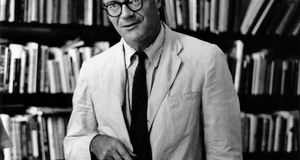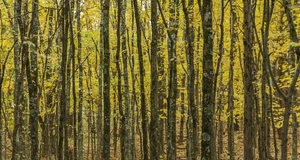The Sexual and the Spiritual in John Donne's Poetry: Exploring "The Extasie" and its Analogues
By
2014, Vol. 6 No. 11 | pg. 2/2 | « After discussing Donne’s as well as others’ notion of ecstasy, one may briefly explicate his poem, “The Extasie” to demonstrate how these ideas are conveyed in his poetry. The poem begins with two lovers who lay together physically (lines 1-12). Their physical union lays the foundation for the subsequent bonding of their souls which have left their bodies and “negotiate” in the ether around the lovers’ bodies (15-20). The description of the elevation and mixing of their souls demonstrates a view that what is taking place should be considered more than mere sex: We see by this it was not sex, Donne’s technique is present in his other poems like “Holy Sonnet XIV.” In this poem, the ecstasy is pondered not between two human lovers, but between the human speaker and God as the speaker begs, “Batter my heart, three-person’d God” (line 1). Payne (1996) notes that: The strategy of the poem appears to be that of a dangerous, blasphemous anthropomorphism in the heat of devotion, but deflecting that danger, just in time, by the equation of sensual passion to spiritual virtue; for the concluding couplet declares that true freedom comes when one is imprisoned by God, and that purity of heart comes with God’s ravishment . . . By the poem’s conclusion the conceit of the rape which ensures chastity no longer skirts blasphemy. In fact, in Donne’s hands, it even becomes orthodox, an ideal of devotion worthy of emulation. (p. 211) The implications of this thought-process are somewhat radical. Donne essentially turns rape into an act that would not only be permissible, but perhaps even desirable or praise-worthy since the perpetrator is God. This renovation of the act of love-making is supported by Clements (1961) who says that “the poem’s theme of love and courtship . . . has been characteristically transformed by Donne to a violent love and courtship” (p. 485). God is perfectly good and cannot be questioned; therefore, if God were to rape someone, that person would be made better as a consequence. Newman (2004) mentions how the poem hints at this idea with its use of the word “ravish:” Here the speaker, impersonating a captive bride, begs to be freed by imprisonment and purified by rape. For that, of course, is the implication of ‘ravish,’ a word with a long and telling history. The verb derives from Latin rapere via Old French ravir: its root meaning is ‘to abduct, rape, carry away by force,’ but metaphorically it can mean ‘to exalt or transport with joy.’ By the thirteenth century, raptus and ravissement could denote either the crime of rape or the experience of mystical ecstasy. (p. 86) Donne’s concept of ecstasy also pervades his poem, “The Good-Morrow.” The first two lines of the poem indicate how the love that the speaker and his partner share is so great that it erases all memory of the meaningless and ignorant past they lived before they met each other (1-2). The second stanza gets into more detail about how the ecstasy of the lovers affects each of their souls: And now good-morrow to our waking souls, The lines describe how the ecstasy of the lovers “makes one little room an everywhere” which means that their souls leave their bodies in the bedroom and are transported to a realm of omnipresence or eternity. The final stanza describes how if their love for each other is equally strong, then the mixture of their souls will allow them to transcend death, “If our two loves be one, or, thou and I / Love so alike, that none do slacken, none can die” (20-21). This representation of love overcoming death marks the power of the ecstasy to make the lovers feel infinite and immortal during their union. Although some look upon Donne’s signature technique of juxtaposing sexual and spiritual language with disapproval, the poet employs this method as it stems from his belief in ecstasy. The fact that several other writers and historical figures have developed strikingly similar theories seems to indicate that there might be a deeper truth behind such an experience. ReferencesBozanich, R. (1975). Donne and ecclesiastes.PMLA, 90(2), 270-76. . Cirillo, A. R. (1969). The fair hermaphrodite: Love-union in the poetry of donne and spenser.Studies in English Literature, 9(1), 81-95. . Clements, A. L. (1961). Donne's holy sonnet xiv.Modern Language Notes,76(6), 484-89. . Huntington, J. (1977). Philosophical seduction in chapman, davies, and donne.ELH,44(1), 40-59. . Mccann, E. (1954). Donne and saint teresa on the ecstasy.Huntington Library Quarterly,17(2), 125-32. . Mitchell, C. (1968). Donne's "the extasie": Love's sublime knot.Studies in English Literature, 8(1), 91-101. . Newman, B. (2004). Rereading john donne's holy sonnet 14.Spiritus, 4(1), 84-90. . Payne, C. (1996). Donne's holy sonnet xiv.The Explicator, 54(4), 209-13. . Suggested Reading from Inquiries Journal
Inquiries Journal provides undergraduate and graduate students around the world a platform for the wide dissemination of academic work over a range of core disciplines. Representing the work of students from hundreds of institutions around the globe, Inquiries Journal's large database of academic articles is completely free. Learn more | Blog | Submit Latest in Literature |


















